After I announced my ‘Hierarchy of Beards’ poster, a fine Marksman named Dan I. shared the following with me. It’s a Beard Photo-Spread from the April 24, 1939 issue of LIFE magazine, full of such gems as the “Norse Skipper”, “Oom Paul Kruger Beard”, and “Double Spitzbart”. The best part is that, as far as I can tell, these are more-or-less accurate names, unlike mine, which are 100% invented from whole cloth. But in a few cases I wasn’t far off! Take a look (click for bigger):
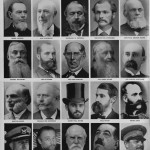
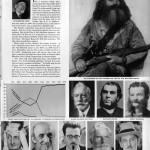
(Full transcription of the text on page 2 is after the cut, below.)
I also recently stumbled across the work of cartoonist William Kerridge Haselden (1872-1953), who drew spot gags and editorial cartoons for the UK’s Daily Mirror from 1903 to 1940. The University of Kent has a fine archive of Haselden’s Mirror cartoons; here’s a few from 1907-16 dealing specifically with the issue of wild and variable beard-stylings:
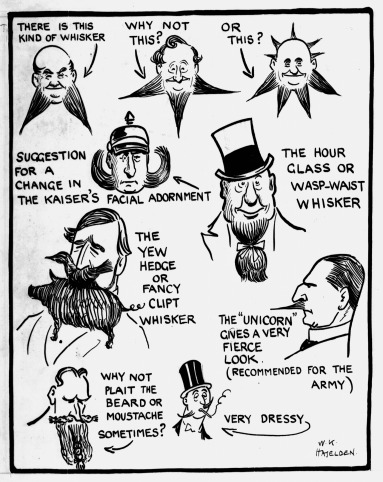
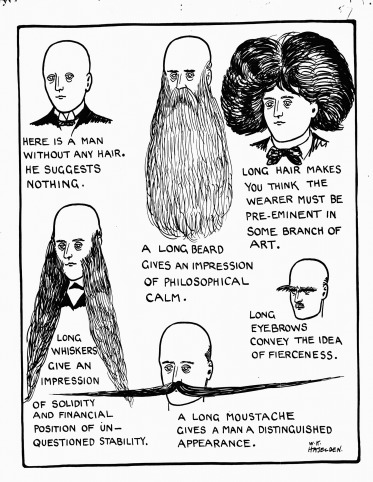
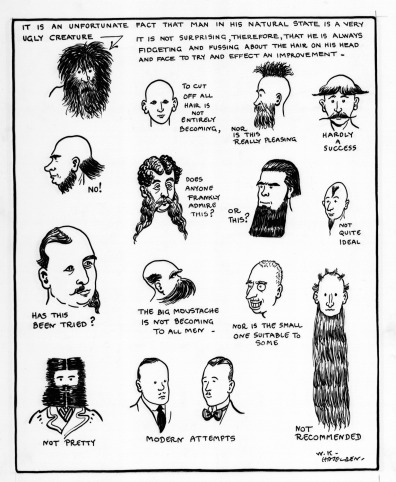
Many more may be found at the British Cartoon Archive.
Finally, I was also made aware this week of a beard-chart similar in tone to mine in the pages of The Affected Provincial’s Companion, a book that will require its own entry on this blog someday:
The only conclusion I can draw from all this is that there is clearly a desperate need for as many facial-hair taxonomies as possible. It reminds me of the Age of Exploration, when rival map-makers would ornament the New World with unique details to make their maps more appealing than the competition, but everyone was working mostly from scribbled sailors’ notes and conjecture.
One day, perhaps not in my lifetime, we will enter an era of satellite beard-imagery and Global Moustache System mapping that will allow Rand McNally and the National Geographic Society and The Mercator Consortium to publish accurate-to-the-square-meter surveys of the lumpy beard-scape all around us. But until then, in these wild and woolly frontier-days of roughshod beard-classifying, I’m glad I’m right at the bleeding edge of the straight-razor. Enjoy!
…THESE ARE “BEAVERS”
The day is past when New York had a mustache-curling salon, and an East Side fish-peddler killed himself in despair after a rival had ripped his extravagantly long mustache out by the roots. Today few Americans would die for their whiskers. Yet America owes much of its existence to bearded explorers like Cabot and De Soto, and in the Golden Age of U.S. whiskers — from late 1850’s to 1900 — the masculine face, as the pictures shown here attest, was an impressive, dignified sight.
The Puritans substituted clean-shaven cheeks for flowing beards. Not one of the Constitution signers was even mustachioed. But in the War of 1812 sideburns appeared. Just before the Civil War the U.S. went hairy on a national scale. Lincoln, Grant, Hayes, Garfield, Arthur, Harrison had hair on their faces. Cleveland, Roosevelt, Taft had mustaches. But after them smooth faces reigned.
Whim seems to have dictated this change in taste. As Lewis Gannett’s chart shows (below), beards were most popular with Harvard seniors in the 1850’s, by 1900 ceased to exist. Mustaches, worn by 59% of class of 1880, lost favor in the 1890’s. Among last year’s 840 seniors, there were only eight mustaches, and with the recent death of Senator James Hamilton Lewis (inset) Congress lost its classiest beard.
“The beard will come back some day,” says Charles De Zemler, New York barbering authority, “because it is a natural and manly ornament to the face.” Yet today only ten out of every 100 U.S. men wear hair on their faces.
With the current resurgence of interest in America’s pioneer past, San Franciscans grew beards to evoke frontier days at the Golden Gate Exposition opening, and for the world premiere of Paramount’s Union Pacific in Omaha whiskers have sprouted. Some Omahans like them so well they may keep them.

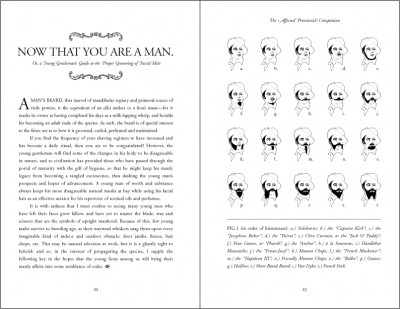
While The Walrus (first page, second row, far right) is impressive, it is put in the shade by the mustache of Paul Capdeville, old-time mayor of New Orleans. http://nutrias.org/~nopl/inv/capdevil.htm The only mustache I have ever seen to cover an entire chin.
There was this t-shirt that does doing the rounds, which also had a similar taxonomy of facial hair – can’t find it now…. hmm… 🙁
As an born and raised Omahan, I do enjoy my facial hair… However, I’ve been in the Air Force for the past 5+ years and have felt something is missing in the way of facial hair. The mustaches we can grow are dull and some times end up looking like Hitlers.
A fellow airman and myself are seeking to document the history of facial hair in the military and present our findings to the uniform board. With the direction of uniform changes aimed at revisiting our heritage, we hope our report will be well received and we can relive the proud tradition of military facial hair.
Who is John Carlton and what is this “Peace Ray” that he invented?
Apologies if this has been mentioned before, but in John Hodgman’s book The Areas of My Expertise, he has a table detailing the name, difficulty of, and tools needed for a number of facial hairs. It lacks illustration, but I’m sure that it will not disappoint.
Threadless has a facial hair t-shirt, but it more pop-culture referencey
http://www.threadless.com/product/677/Facial_Hair_Club_For_Men